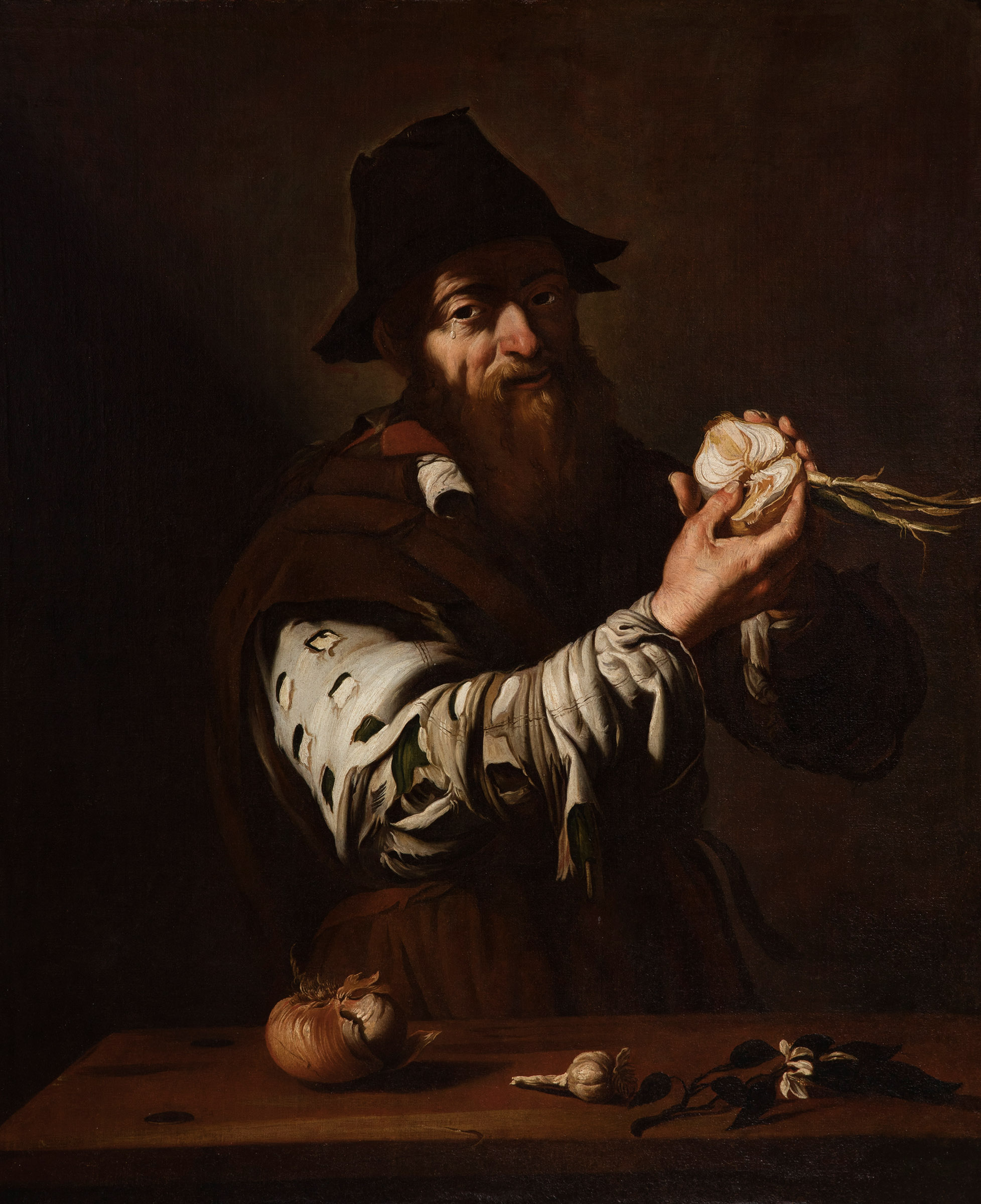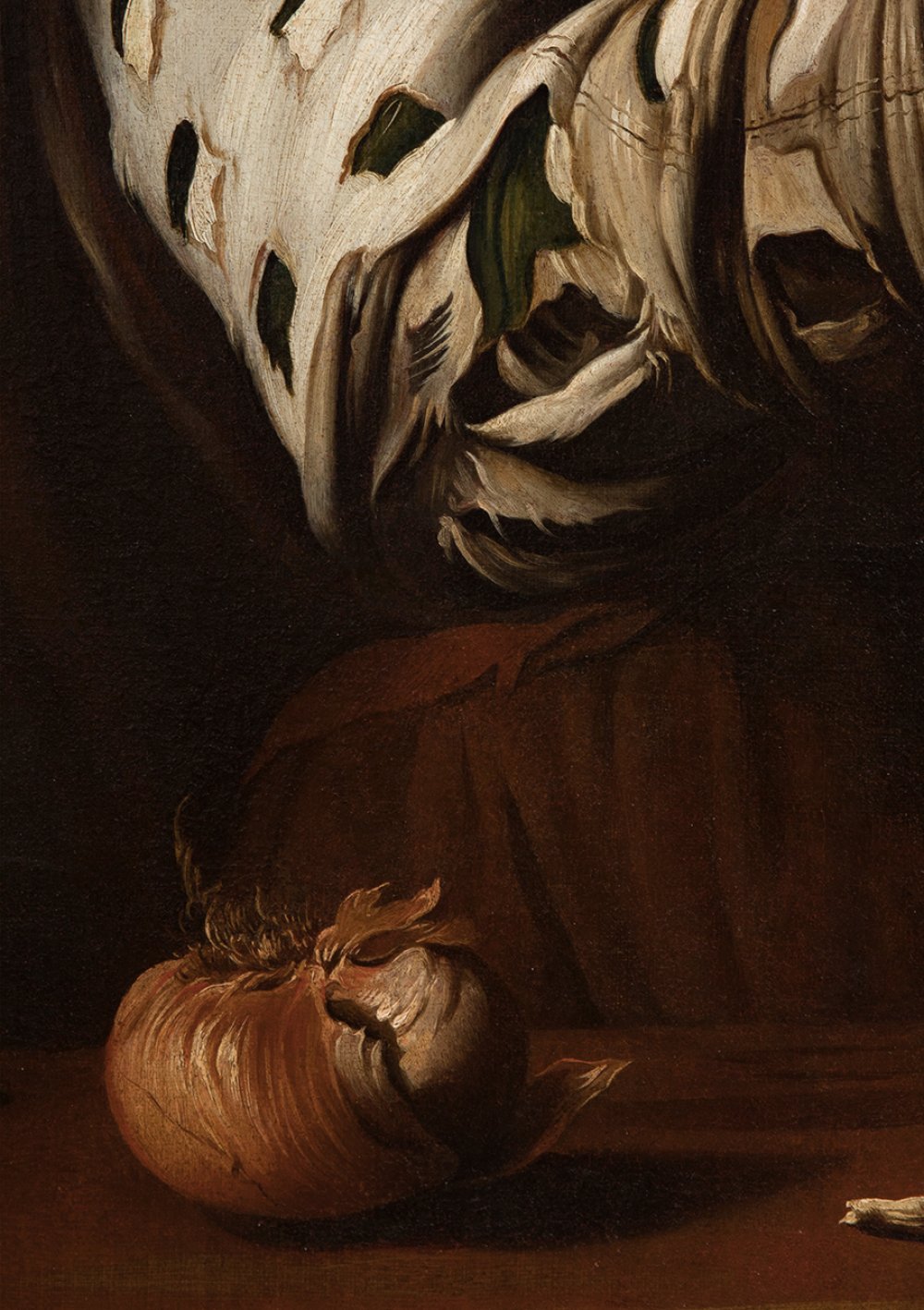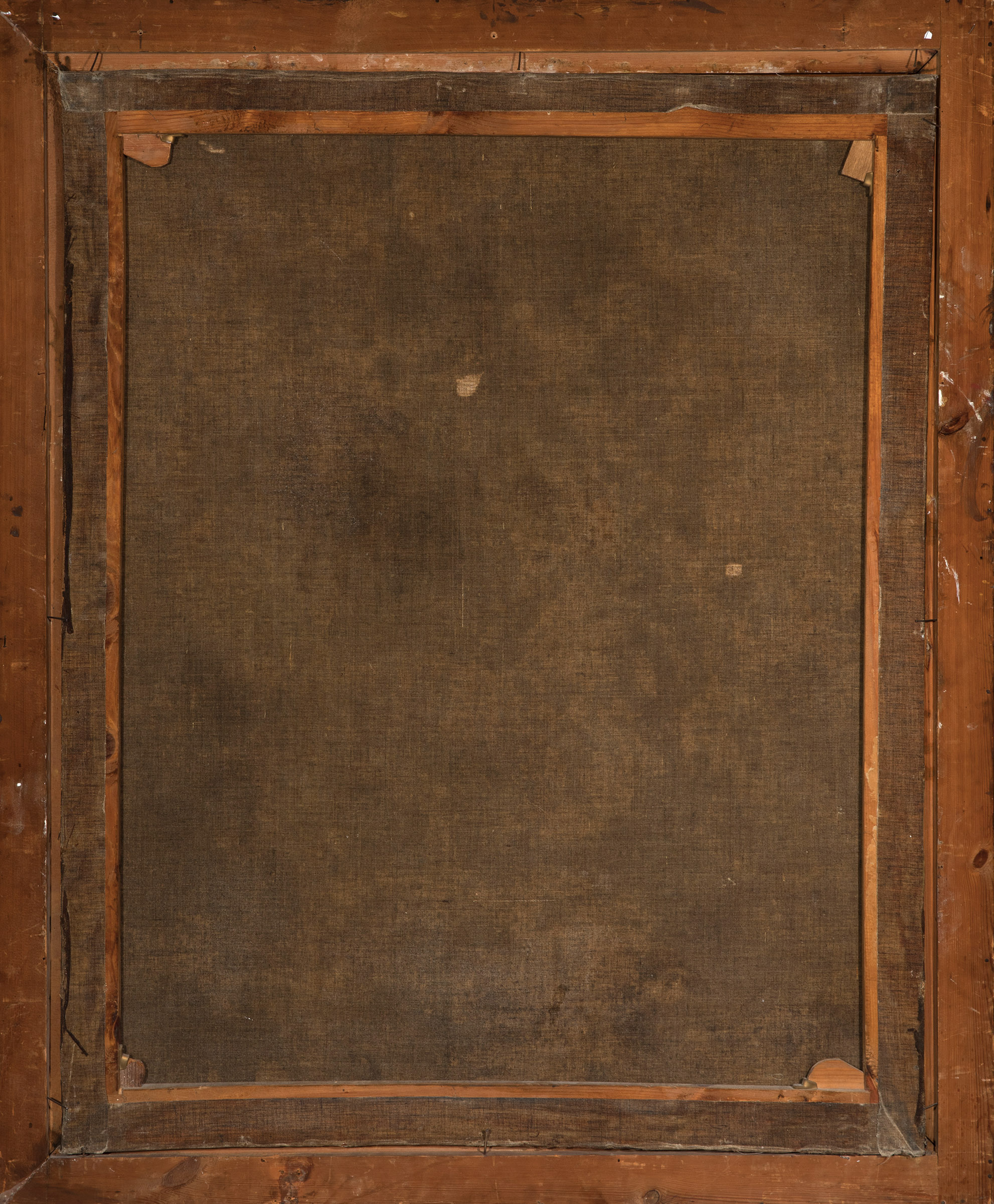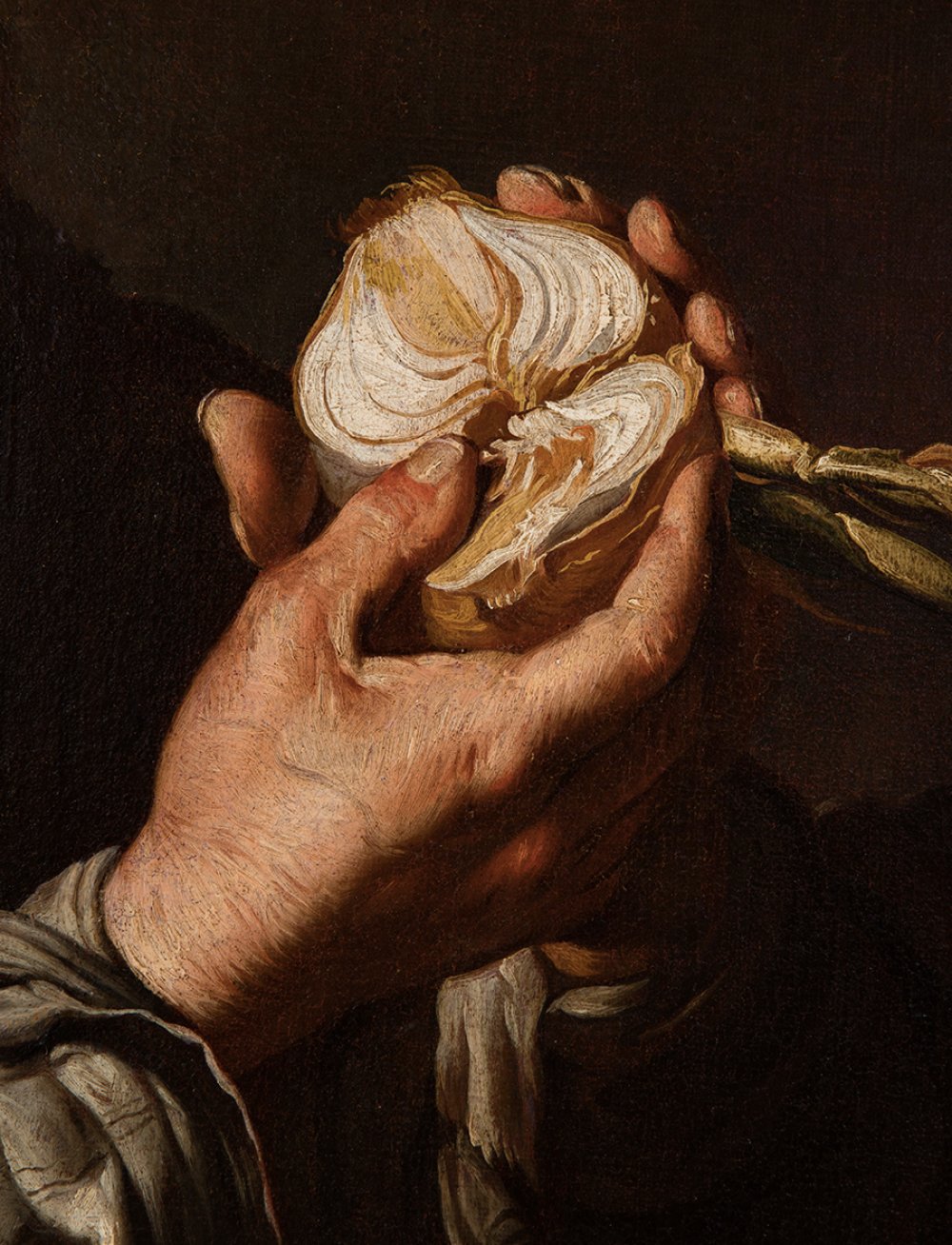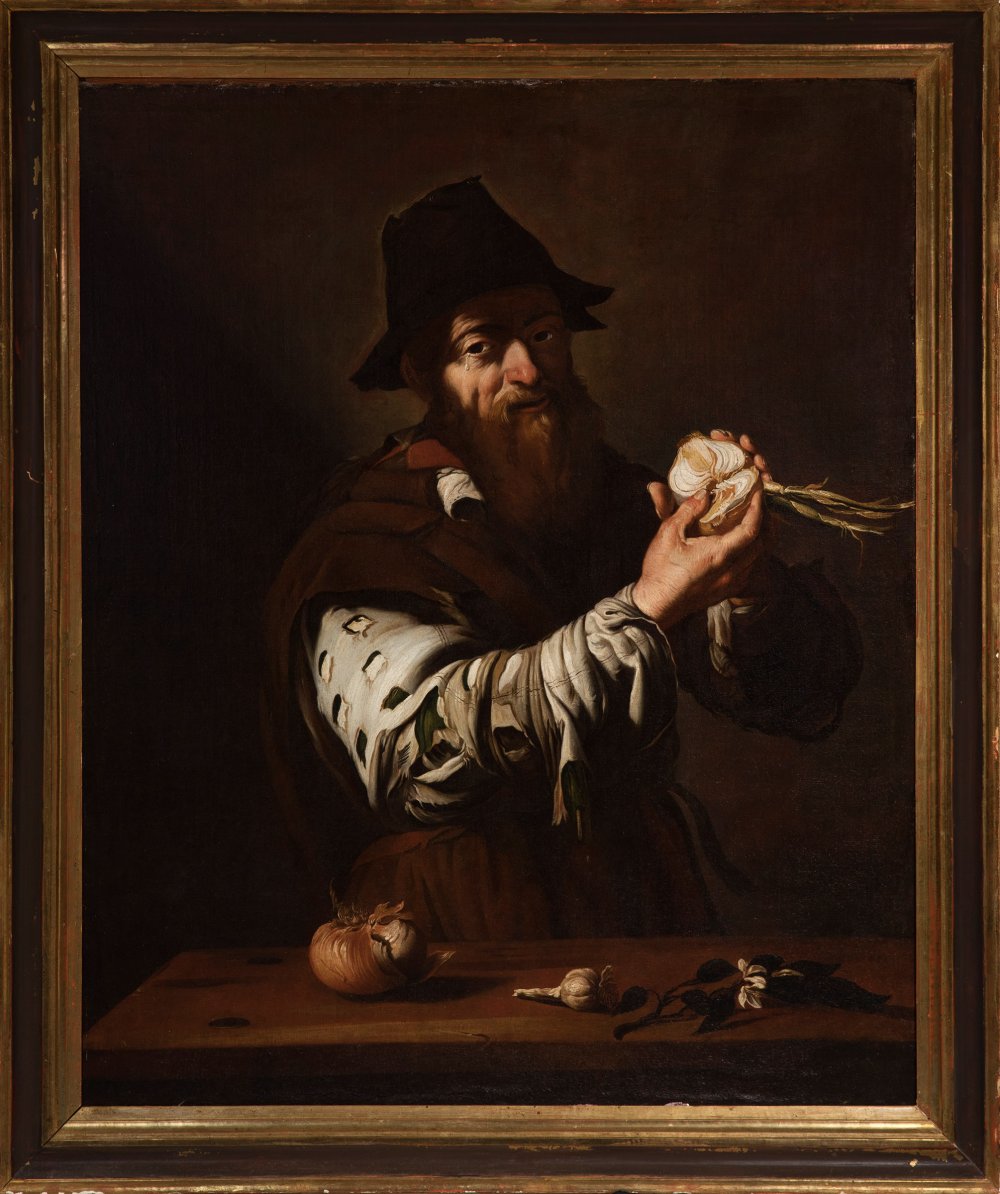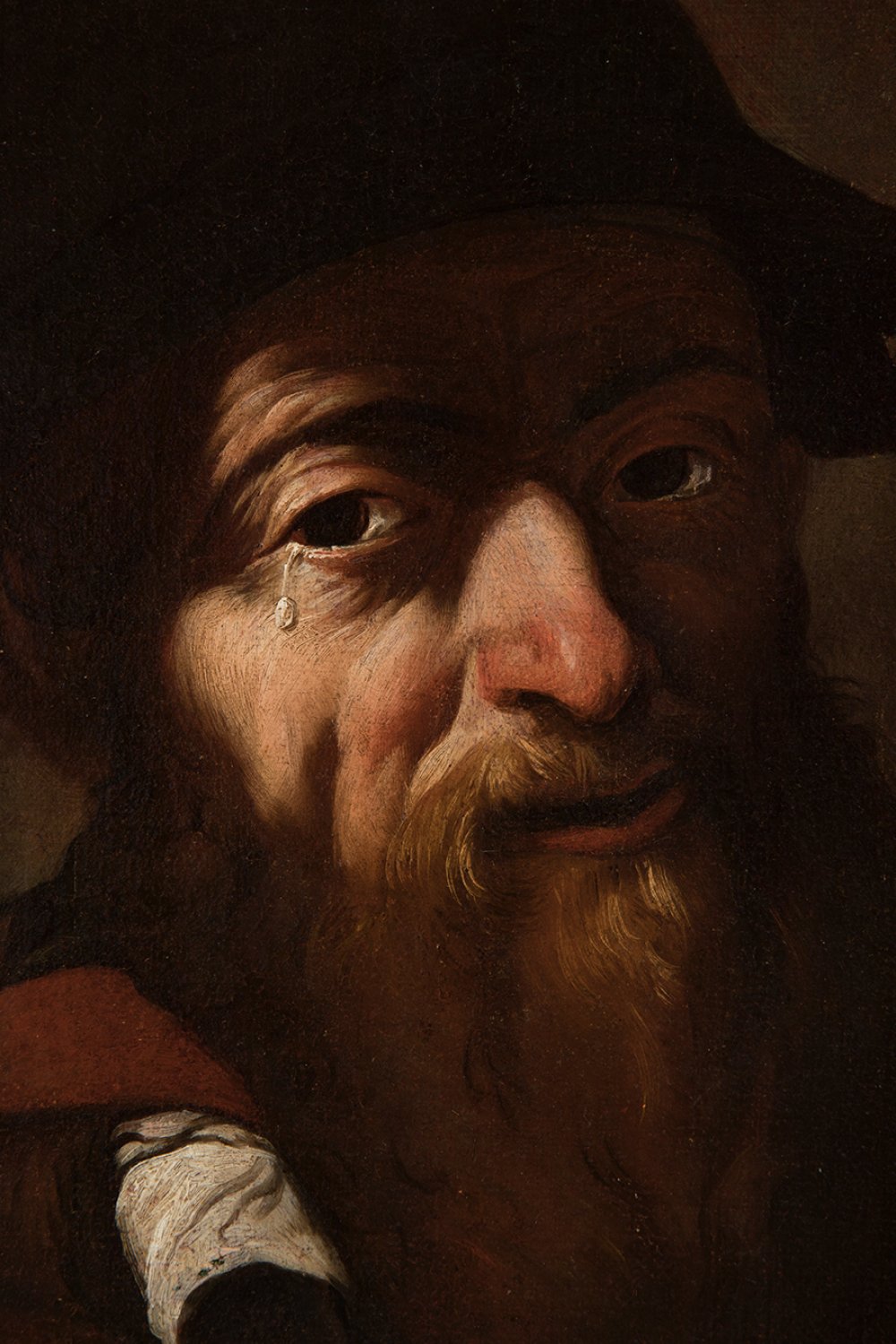56
JOSÉ DE RIBERA Y TALLER (Xátiva, Valencia, 1591 - Naples, 1652)."The Smell".Oil on canvas. Relined.
"The Smell".
Oil on canvas. Relined.
Size: 112 x 89,5 cm; 126,5 x 104 cm (frame).
In this work the artist has captured the image in a naturalistic style inspired by the one who takes the violent tenebrist illumination and the humble figures. The piece faithfully follows the work "El Olfato", which was made between 1613 and 1616 by José Ribera during his stay in Rome, following the style inspired by Caravaggio and Flemish painting. The piece currently belongs to the private collection of Abelló. In the piece we can see how the influence of Caravaggio is combined with aesthetic characteristics typical of Flemish art, of which the artist was aware thanks to his close relationship with his neighbours on Via Margutta. The iconography of the image has undergone a major shift away from the elegant and complex visions of the Five Senses painted in the Low Countries, which are among the most famous. The Valencian master depicts a beggar with an onion in his hands that makes him cry. On the table we find another onion and a head of garlic, the bad smell of which contrasts with the orange branch next to them. The intense, direct lighting accentuates the contrasts of light and shadow and creates an accentuated diagonal on the wall, similar to that used by Caravaggio in The Vocation of Saint Matthew for Saint Louis of the French. The naturalism with which he treats the figure almost borders on the grotesque, demonstrating Ribera's ability to depict all kinds of characters. It is curious to compare this image with the works of the Five Senses painted by Brueghel, with Ribera replacing Flemish elegance with a new vision that is closer to the viewer.
José de Ribera, known as the Españoleto, was a key master of the Spanish Baroque and of European art history in general. Although no documentary sources or evidence of his youth survive, it is thought that he trained with Francisco Ribalta in Valencia, after which he went to Italy, first to the north and later to Rome, where he became acquainted at first hand with the classicists and the tenebrism of the Dutch who settled there. He finally settled in Naples, where he arrived in 1616. This was the beginning of his period of maturity and splendour; Ribera enjoyed fame and a large studio, and his works were disseminated throughout Europe through engravings. He worked for viceroys and high-ranking officials of Spanish origin in Naples, and many of his works soon reached Spain. He was in fact famous in his native country, and in fact Velázquez himself visited him in 1630. Works by Ribera are now held in the Prado, the Louvre, Capodimonte, the Fine Arts Museum in Budapest, the Hermitage in St Petersburg, the Kunsthistorisches and Liechtenstein Museums in Vienna, the J. Paul Getty in Los Angeles, the Art Institute in Chicago, the Metropolitan in New York, the National Gallery and the Royal Collection in London, the Borghese Gallery in Rome and other leading art galleries in Europe, America and Asia.
"The Smell".
Oil on canvas. Relined.
Size: 112 x 89,5 cm; 126,5 x 104 cm (frame).
In this work the artist has captured the image in a naturalistic style inspired by the one who takes the violent tenebrist illumination and the humble figures. The piece faithfully follows the work "El Olfato", which was made between 1613 and 1616 by José Ribera during his stay in Rome, following the style inspired by Caravaggio and Flemish painting. The piece currently belongs to the private collection of Abelló. In the piece we can see how the influence of Caravaggio is combined with aesthetic characteristics typical of Flemish art, of which the artist was aware thanks to his close relationship with his neighbours on Via Margutta. The iconography of the image has undergone a major shift away from the elegant and complex visions of the Five Senses painted in the Low Countries, which are among the most famous. The Valencian master depicts a beggar with an onion in his hands that makes him cry. On the table we find another onion and a head of garlic, the bad smell of which contrasts with the orange branch next to them. The intense, direct lighting accentuates the contrasts of light and shadow and creates an accentuated diagonal on the wall, similar to that used by Caravaggio in The Vocation of Saint Matthew for Saint Louis of the French. The naturalism with which he treats the figure almost borders on the grotesque, demonstrating Ribera's ability to depict all kinds of characters. It is curious to compare this image with the works of the Five Senses painted by Brueghel, with Ribera replacing Flemish elegance with a new vision that is closer to the viewer.
José de Ribera, known as the Españoleto, was a key master of the Spanish Baroque and of European art history in general. Although no documentary sources or evidence of his youth survive, it is thought that he trained with Francisco Ribalta in Valencia, after which he went to Italy, first to the north and later to Rome, where he became acquainted at first hand with the classicists and the tenebrism of the Dutch who settled there. He finally settled in Naples, where he arrived in 1616. This was the beginning of his period of maturity and splendour; Ribera enjoyed fame and a large studio, and his works were disseminated throughout Europe through engravings. He worked for viceroys and high-ranking officials of Spanish origin in Naples, and many of his works soon reached Spain. He was in fact famous in his native country, and in fact Velázquez himself visited him in 1630. Works by Ribera are now held in the Prado, the Louvre, Capodimonte, the Fine Arts Museum in Budapest, the Hermitage in St Petersburg, the Kunsthistorisches and Liechtenstein Museums in Vienna, the J. Paul Getty in Los Angeles, the Art Institute in Chicago, the Metropolitan in New York, the National Gallery and the Royal Collection in London, the Borghese Gallery in Rome and other leading art galleries in Europe, America and Asia.
26th October - Old Masters
Sale Date(s)
Venue Address
General delivery information available from the auctioneer
Setdart offers Worldwide shipping
PICK UP IN ROOM: You can come and pick up your lots in our offices (Barcelona, Madrid or Valencia). At the moment of the withdrawal, you will be able to accept the current conditions of the lot by means of a document that you will sign.
YOU CAN SEND ANOTHER PERSON TO PICK UP: This person must present a signed authorization that you can find in our web page by accessing from BUY AT SETDART- LOGISTICS-DOWNLOAD AUTHORIZATION DOCUMENT. You can also send an e-mail with the requested data in AUTHORIZATION DOCUMENT to admin@setdart.com
Important Information
25% buyer´s premium
21% buyer´s premium at www.setdart.com
Terms & Conditions
The maximum period to pay the lots is 7 working days. You can pay either via bank transfer or with credit card through our platform www.setdart.com (we only accept VISA or Mastercard).
BUYER´S PREMIUM: 22% Hammer price + 21% VAT from the buyer´s premium
If your piece has more than 100 years, our Ministry of Culture requires an export certificate in order for the piece to leave the country. Note that if the piece goes inside the EU, there is no cost for the export certificate. If the piece goes outside the EU, there is a cost for the export certificate. You can find more information in our Ministry of Culture website: https://www.culturaydeporte.gob.es/en/cultura/patrimonio/exportacionimportacion/exportacion/tasas.html
INQUIRIES: admin@setdart.com
Setdart guides you through the entire process, from the time of award to the day you receive your lot. Our logistics team will be happy to manage your transport, and will advise you on the best shipping method with professionals from the sector used to handling works of art and jewelry.
WE OFFER WORLDWIDE DOOR TO DOOR SHIPPING
PICK UP IN ROOM: You can come and pick up your lots in our offices. At the moment of the withdrawal, you will be able to accept the current conditions of the lot by means of a document that you will sign.
YOU CAN SEND ANOTHER PERSON TO PICK UP: This person must present a signed authorization that you can find in our web page by accessing from BUY AT SETDART-LOGISTICS-DOWNLOAD AUTHORIZATION DOCUMENT. You can also send an e-mail with the requested data in AUTHORIZATION DOCUMENT to admin@setdart.com
SETDART IS NOT RESPONSIBLE FOR THE STATE OF THE PARTS ONCE THEY LEAVE OUR FACILITIES. MRW SHIPMENTS: Once the payment is made, your lot will be packed for shipment, the logistics department will send you an e-mail notifying you of the day it leaves our warehouse, changes of address cannot be made after receiving this e-mail.
INSURANCE INCIDENTS: Coverage for the value of the auction up to 3000 ? per shipment, if the value of the auction is higher, Setdart will send you a quote including the additional insurance. The insurance company WILL NOT BE RESPONSIBLE FOR THE SHIPMENT THAT EXCEEDS THAT AMOUNT AND IS NOT FULLY INSURED. MRW INCIDENTS: Maximum notification 48 hours after receipt, after which the insurance company WILL NOT BE RESPONSIBLE AND NO CLAIMS WILL BE ACCEPTED.
E-MAIL LOGISTICS: logistica@setdart.com
PICK UP YOUR MESSAGES: You can send your own messaging, prior notice via e-mail that your shipment is ready, please note 3 or 4 days in advance. This type of shipment is packaged so Setdart will provide you with a quote.
EXPENSES FOR STORAGE: We inform you that if the purchased lot is not picked up within a month, you will be charged 30€ per week per lot. Setdart Online S.L., owner of the web site "setdart.com", "setdart.net" and "setdart.org", acts as a company of Spanish nationality inscribed in the Volume 36955, sheet 182, page B-293056 of the Mercantile Registry, with registered office at Calle Aragó















